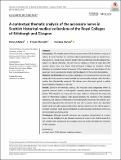Files in this item
A contextual thematic analysis of the accessory nerve in Scottish historical medical collections of the Royal Colleges of Edinburgh and Glasgow
Item metadata
| dc.contributor.author | Marles, Henry | |
| dc.contributor.author | Chisholm, Fraser | |
| dc.contributor.author | Varsou, Ourania | |
| dc.date.accessioned | 2020-05-07T12:30:02Z | |
| dc.date.available | 2020-05-07T12:30:02Z | |
| dc.date.issued | 2020-04-16 | |
| dc.identifier | 267210273 | |
| dc.identifier | 49b54255-7b38-49ed-84ba-8b9919fcc646 | |
| dc.identifier | 85083454346 | |
| dc.identifier | 000526560900001 | |
| dc.identifier.citation | Marles , H , Chisholm , F & Varsou , O 2020 , ' A contextual thematic analysis of the accessory nerve in Scottish historical medical collections of the Royal Colleges of Edinburgh and Glasgow ' , Clinical Anatomy , vol. Early View . https://doi.org/10.1002/ca.23593 | en |
| dc.identifier.issn | 0897-3806 | |
| dc.identifier.other | RIS: urn:E011DC7B6B90151763D24E0BA0C22155 | |
| dc.identifier.other | ORCID: /0000-0003-3069-4130/work/71560015 | |
| dc.identifier.uri | https://hdl.handle.net/10023/19900 | |
| dc.description | Funding: Authors acknowledge that this work was conducted as part of the University of St Andrews Laidlaw Undergraduate Research and Leadership Programme, which funded Henry Marles’ summer scholarship for 2017/18 and 2018/19. | en |
| dc.description.abstract | Introduction The classification of the accessory nerve (CN XI) remains a source of debate; its exact function has not been fully elucidated having also an atypical morphology for a cranial nerve. A better insight into its anatomical and physiological features is of clinical relevance. The aim was to conduct a review of 18th and 19th century books from the Royal Medical/Surgical Colleges in Scotland, UK. A contextual historical analysis of the depictions and descriptions of the accessory nerve could provide insight into the disparity in the current descriptions. Materials and Methods Online archive catalogues were systematically searched and, during site visits, resources were formally and contextually analyzed, with the information then thematically analyzed. The themes were discussed against a widely known reference textbook of the era. Results Based on the thematic analysis, the resources were categorized either as practical anatomy books or field‐specific anatomy books including neuroanatomy atlases. This intended use, along with the target audience, influenced the scope and detail of information, typically with general anatomy for students in the practical resources, and specialist information in the field‐specific resources. The authors’ professional background also influenced the way the accessory nerve was described and/or depicted, with surgeons/physicians placing emphasis on the clinical aspects. Content variations could also be attributed to communication restrictions of the era, and associated purchasing costs. Conclusions Although scientific advances are nowadays disseminated at a faster pace, actively bridging the gap between anatomical sciences and clinical research is still needed when considering the accessory nerve to further elucidate the mysteries of this structure. | |
| dc.format.extent | 8 | |
| dc.format.extent | 2373838 | |
| dc.language.iso | eng | |
| dc.relation.ispartof | Clinical Anatomy | en |
| dc.subject | Accessory nerve | en |
| dc.subject | CN XI | en |
| dc.subject | History of medicine | en |
| dc.subject | Rare books | en |
| dc.subject | DA Great Britain | en |
| dc.subject | R Medicine (General) | en |
| dc.subject | 3rd-DAS | en |
| dc.subject.lcc | DA | en |
| dc.subject.lcc | R1 | en |
| dc.title | A contextual thematic analysis of the accessory nerve in Scottish historical medical collections of the Royal Colleges of Edinburgh and Glasgow | en |
| dc.type | Journal article | en |
| dc.contributor.institution | University of St Andrews. School of Medicine | en |
| dc.contributor.institution | University of St Andrews. Education Division | en |
| dc.identifier.doi | https://doi.org/10.1002/ca.23593 | |
| dc.description.status | Peer reviewed | en |
This item appears in the following Collection(s)
Items in the St Andrews Research Repository are protected by copyright, with all rights reserved, unless otherwise indicated.

